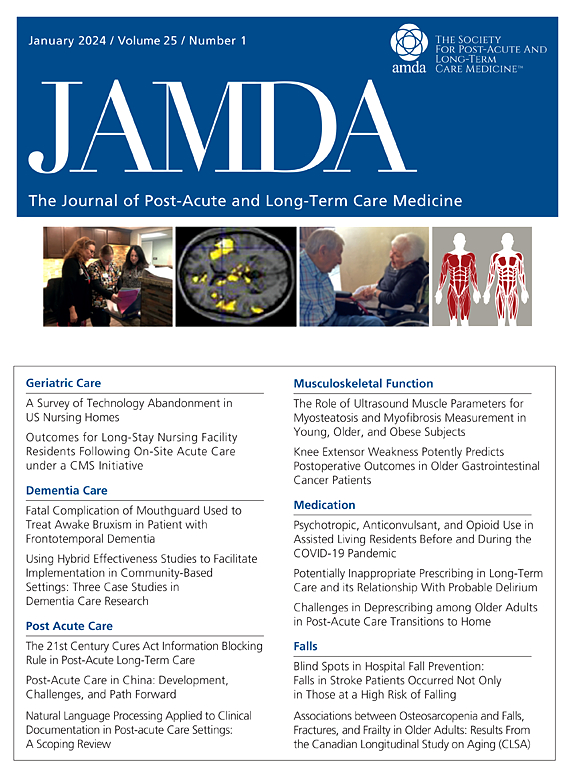呼吸道合胞病毒(RSV)对长期护理环境中老年人的不成比例影响
IF 4.2
2区 医学
Q2 GERIATRICS & GERONTOLOGY
Journal of the American Medical Directors Association
Pub Date : 2025-07-24
DOI:10.1016/j.jamda.2025.105760
引用次数: 0
摘要
目的:呼吸道合胞病毒(RSV)感染在长期护理机构(LTCF)人群中的全部负担尚未明确定义。本研究旨在量化与社区老年人相比,居住在ltcf的老年人RSV感染、住院和院内死亡的负担。设计:回顾性队列研究。环境和参与者:纽约州门罗县,在2022-2023和2023-2024 RSV季节,65岁及以上RSV检测结果阳性的成年人。方法:采用基于人群的监测方法收集资料。居住类型分为熟练护理设施(LTCF)或辅助生活设施(ALFs)或社区居住(CD)。计算RSV感染及并发症发生率;比较LTCF患者与CD成人的并发症发生率。生成针对snf的攻击率。结果:监测期间共发现RSV感染病例1660例(SNF 270例,ALF 68例,CD 1322例)。SNF居民的平均感染率为4151.9 / 10万人,ALF居民为1635.0 / 10万人,CD老年人为503.7 / 10万人。SNF居民的住院率比CD成人高6.6倍,ALF居民的住院率比CD成人高7.2倍。LTCF患者的住院死亡率显著高于CD患者,SNF患者的住院死亡率是CD患者的16.6倍,ALF患者的住院死亡率是CD患者的18.5倍。snf的季节性攻击率在0.3%至28.5%之间。结论和意义:RSV对snf和alf的LTCF患者的影响不成比例,与CD老年人相比,这些人群的住院率和死亡率更高。我们的研究结果强调了在ltcf中需要有针对性的RSV预防策略,包括常规疫苗接种和感染检测,以减轻RSV的影响。需要进行持续监测,以评估这些干预措施的有效性,并监测这一脆弱人群中的RSV趋势。本文章由计算机程序翻译,如有差异,请以英文原文为准。
Disproportionate Impact of Respiratory Syncytial Virus (RSV) Among Older Adults in Long-Term Care Settings
Objectives
The full burden of respiratory syncytial virus (RSV) infection in the long-term care facility (LTCF) population is not well defined. This study aimed to quantify the burden of RSV infection, hospitalization, and in-hospital death in older adults residing in LTCFs compared with those in the community.
Design
Retrospective cohort study.
Setting and Participants
Monroe County, NY, adults aged 65 years and older with positive RSV test results during the 2022–2023 and 2023–2024 RSV seasons.
Methods
Data were collected through population-based surveillance. Residence type was classified as LTCF [skilled nursing facilities (SNFs) or assisted living facilities (ALFs)] or community-dwelling (CD). RSV infection and complication rates were calculated; complication rates in LTCF residents were compared with CD adults. SNF-specific attack rates were generated.
Results
A total of 1660 RSV infections were identified (270 SNF, 68 ALF, 1322 CD) during the surveillance period. The average infection rates were 4151.9 per 100,000 persons for SNF residents, 1635.0 for ALF residents, and 503.7 for CD older adults. Hospitalization rates were 6.6 times higher in SNF residents and 7.2 times higher in ALF residents compared with CD adults. In-hospital mortality rates were significantly higher in LTCF residents, with the rate in SNF residents 16.6 times and ALF residents 18.5 times higher than in CD adults. Seasonal attack rates in SNFs varied between 0.3% and 28.5%.
Conclusions and Implications
RSV disproportionately impacts LTCF residents in both SNFs and ALFs, with these populations experiencing much higher hospitalization and mortality rates compared with CD older adults. Our findings underscore the need for targeted RSV prevention strategies in LTCFs, including routine vaccination and infection detection, to mitigate the impact of RSV. Ongoing surveillance is needed to evaluate the effectiveness of these interventions and monitor RSV trends in this vulnerable population.
求助全文
通过发布文献求助,成功后即可免费获取论文全文。
去求助
来源期刊
CiteScore
11.10
自引率
6.60%
发文量
472
审稿时长
44 days
期刊介绍:
JAMDA, the official journal of AMDA - The Society for Post-Acute and Long-Term Care Medicine, is a leading peer-reviewed publication that offers practical information and research geared towards healthcare professionals in the post-acute and long-term care fields. It is also a valuable resource for policy-makers, organizational leaders, educators, and advocates.
The journal provides essential information for various healthcare professionals such as medical directors, attending physicians, nurses, consultant pharmacists, geriatric psychiatrists, nurse practitioners, physician assistants, physical and occupational therapists, social workers, and others involved in providing, overseeing, and promoting quality

 求助内容:
求助内容: 应助结果提醒方式:
应助结果提醒方式:


